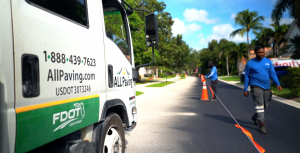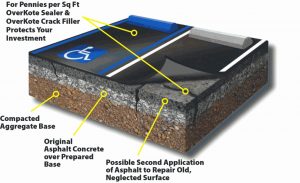
Sealcoating can refurbish asphalt and give it a new, radiant, smooth black appearance while simultaneously providing a protective coating that safeguards against future damage and greatly enhances the lifespan of the asphalt surface.
You can improve the look and durability of your current asphalt service at a fraction of the price with sealcoating, or simply give it a protective coat that will help it to resist harsh temperatures, weather conditions, and sun exposure over the years.
What is Sealcoating?
Sealcoating is an asphalt emulsion mixture that consists of a blend of water and an aggregate to create a textured layer that is easily absorbed and blended with the current asphalt.
The amount of emulsion and seal coating used depends on the state of the current asphalt and if it has ever been sealcoated in the past.
The more damaged or worn the asphalt, the more texturized the mixture will need to be to allow for smooth blending and the like-new appearance that sealcoating is able to achieve.
Why is Sealcoating Important?
 Asphalt sealcoating is important for two reasons – it is able to fortify existing asphalt surfaces while also making them appear dark black and brand new. This process does not repair or cure the asphalt, it simply adds a finishing layer that makes it much more durable and resistant to wear and tear.
Asphalt sealcoating is important for two reasons – it is able to fortify existing asphalt surfaces while also making them appear dark black and brand new. This process does not repair or cure the asphalt, it simply adds a finishing layer that makes it much more durable and resistant to wear and tear.
A new and fresh slab of asphalt is not complete until a sealcoating layer is applied, as this process allows for the lifespan and integrity of the layer to remain intact for much longer than it would without the protective layer.
How is Sealcoating Applied?
The sealer is applied either by squeegee or a spray.

Any cracks, depth problems, or surface blemishes are first repaired prior to laying down this coat as the layers beneath must be perfectly laid up to standard before being finalized by the sealcoat.
The area is then thoroughly cleaned and prepped for the coating process.
Then, an adhesive layer is applied to ensure that the sealcoating adheres to the asphalt layer beneath it.
The sealcoating is then applied by spray for the flat surfaces and squeegee for curbs and non-level surfaces such as curbing.
In some cases sealcoating process requires multiple coats for desired results.
Regardless of which method is used to apply the sealer, the process is the same:
- If any Asphalt Repairs are necessary, they must be performed first and allowed to fully cure before sealcoating.
- Barricades and string line are used to cordon off the area where sealer is going to be applied to prevent disruption to the surface.
- Large blowers and brooms are used to clean the area of dust, dirt, debris and other detritus.
- In areas where there are oil stains that have not penetrated deep enough to necessitate repairs, a petro-bond is layered to the surface to ensure the sealer adheres to the oil-stained asphalt.
- Sealer is either sprayed or squeegeed onto the surface. Intricate areas such as around car stops, curbing, or non-asphalt materials such as paver bricks always have the sealer applied via squeegee.
- On projects that require a second coat, the first coat is allowed to dry (usually 3-5 hours) before the second coat is applied.
